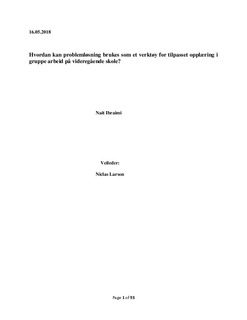| dc.description.abstract | Research on collaborative learning has been ongoing for almost 30 years since the first studies in this topic in 1988 (Akdemir & Arslan, 2012). There were researchers Roger T. & David W. Johnson in the study Cooperative Learning: Two, heads learn better than one, who took this topic up in research. Since then, there has been a lot of research on this. Part of this research focused on collaborative learning at the students; when they worked on problem solving tasks such as The Thinking Together project in the UK. The project is based on over two decades of classroom research and deals with the relationship between talk and thinking (Thinking Together, 2018). This research is based on the socio-cultural learning perspective (Howe & Mercer, 2012). What I can not find is studies that connect such research directly to custom training. Indirectly, research shows positive effects of working together in groups with problem solving tasks such as development of: critical mathematical thinking, skills for cooperation, various strategies for solving the problems outside of school etc. (eg, Căprioarăa 2014; Howe & Mercer, 2012). The research question that this study tries to answer is: How can problem solving be used as a tool for custom training in group work at high school? I start with collaborative learning based on sociocultural learning theory and problem-solving tasks; to find out whether this has a positive effect on custom training in the classroom. It turns out that this is easier said than done, although there are indications that this suited most students (according to their comments). There are big challenges for both the students and the teacher if this will be successful, and if the students will get the most learning outcomes from this. Establishing a good collaboration environment in the classroom between students takes time (Howe & Mercer, 2012). There is a demanding and big challenge in today's classroom, where much of the work is governed by the competence objectives set by the curriculum. Nevertheless, this is a start to something that I think has great potential to equip students to the daily life that comes after school education, as well as to solve the challenges and problems they face in the various situations of life. "Many students need constructive experiences to face difficulties and problems so that they find that this is something it's possible to do something about" (Håstein & Werner, 2014 p.52). | nb_NO |

